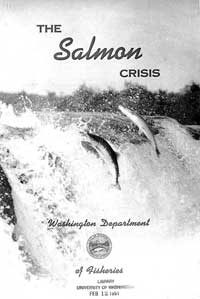Salmon in the Pacific Northwest and Alaska Collection, 1890-1961
Salmon in the Northwest contains documents, photographs and other original material describing the roots of the salmon crisis in the Pacific Northwest in the late 19th and early 20th centuries.
The Pacific Northwest region provides an exceptionally rich and nurturing environment for salmon. For the indigenous peoples of this area, salmon played a critical role in both the local economy and culture. Over a period of 1500 years, a sustainable balance between salmon and human ecosystems evolved. Harvest rate and fish losses were often due to natural phenomena and aboriginal fishing methods. However, with the arrival of early pioneers and entrepreneurs to the region in the 19th century, a dramatic change took place in the level of fishing and the techniques employed to gather the salmon. The advent of a new market-driven industrial economy provided new vulnerabilities for the Pacific Northwest's salmon runs.
Initially, salmon remained abundant. Early Euro-American settlers viewed the wealth of the rivers as an inexhaustible resource. Fish were harvested primarily at a subsistence level during the early 19th century; commercial production was viewed as unfeasible and difficult. However, dreams of economic prosperity from salmon rapidly led to increased fishing. In 1866 the first salmon cannery on the Columbia River, the Hapgood, Hume and Company, opened for business. Canned salmon quickly became a cheap food source for the working class. By 1883, over 50 such canneries operated in the Columbia River Basin. The salmon industry also supported 2600 commercial fishermen, who worked to supply fish for the canneries. Both cannery employees and fishermen relied heavily upon salmon for their livelihoods.
Fishermen utilized many methods to ensnare salmon, including fishwheels, horse seining, gillnets, and traps. In the early years, these practices were mostly unregulated and left to the determination of the fishermen themselves. Chinese laborers and foreign workers were largely excluded from salmon fishing. Some worked in canneries, but were generally viewed as greedy entrepreneurs and often blamed for the depletion of salmon runs. One of the principal reasons for the decline in salmon was simply that the more the markets demanded, the more the fishermen provided. As competition among fishermen increased, battles erupted among salmon fisheries over equipment use and fishing rights. Fishermen petitioned government agencies to prohibit certain types of commercial fishing practices and to restrict fishing in certain areas. As fish runs declined, artificial propagation was considered as a viable alternative to save the salmon.
Cannery operators believed the salmon supply to be endless, and as a consequence, the salmon industry quickly grew wasteful. Not only were large portions of the fish discarded, but also many complete species of fish were discarded, as the fishermen caught more fish than the canneries could process. During the spring and summer seasons, often the canneries processed only Chinook salmon. Canneries dumped other species back into the rivers. In 1895 it was estimated that 7 million pounds of fish were discarded. By the 1890s the fish population was declining.
By the turn of the 20th century, early conservationists began to sound the alarm that salmon runs were being depleted. In addition to the effect of natural environmental conditions and depletion of fish stock, the influence of logging, mining, irrigation, and commercial fishing were being felt. Rapid deterioration of fish habitat became evident in the early pollution of the rivers and spawning streams. By the 1930s, large-scale dam projects posed additional barriers for migrating fish.
Immediate efforts to resolve the problems during these periods were intermediate and poorly conceived, in part because the problems were not fully understood. The problems are complex, and touch upon the issues of Native American rights, the livelihood of commercial fishermen, and the hydroelectric needs of the Pacific Northwest. Maintaining the salmon and balancing the conflicting needs of the different peoples of the region remains one of the core social and economic controversies in the Pacific Northwest.
About the Database
The information for Salmon Collection was researched and prepared by the UW Libraries Special Collections Division in 2001. The textual materials in this database are selections from various pamphlet and book collections held at the UW Libraries Special Collections Division. The text was scanned using a Microtek ScanMaker 9600XL and saved in .jpg format. Some manipulation of the images was done to present the clearest possible digital image. The scanned images were then linked with descriptive data using CONTENTdm software.

